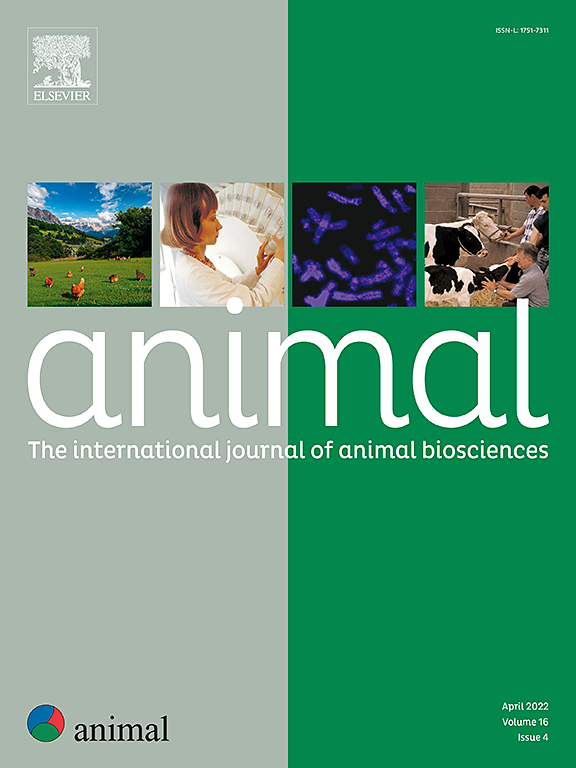低碳水化合物或高碳水化合物日粮对尼罗罗非鱼幼鱼和成鱼中间碳水化合物代谢的影响
IF 4
2区 农林科学
Q1 AGRICULTURE, DAIRY & ANIMAL SCIENCE
引用次数: 0
摘要
一般来说,在养殖鱼类的生命周期中,经常会出现能量消耗以及根据断食和补饲进行能量补偿的情况。禁食和补饲也被认为可调节碳水化合物代谢,尤其是对草食性和/或杂食性鱼类而言。本研究旨在调查短期禁食和随后的高碳水化合物或低碳水化合物饮食对尼罗罗非鱼(Oreochromis niloticus)幼鱼和成鱼中间碳水化合物代谢的影响。对鱼类禁食 4 天,然后用低碳水化合物和高蛋白(LC/HP)或高碳水化合物和低蛋白(HC/LP)饮食再喂养 4 天。我们的研究结果表明,使用其中一种饮食进行为期 4 天的补饲可以弥补禁食造成的体重减轻。因此,我们研究了 4 天回饲策略和不同碳水化合物回饲饮食对成鱼血浆代谢物、营养成分以及肝脏和肌肉中葡萄糖及其相关代谢的影响。再喂食对成鱼和幼鱼的影响相似,都会引起中间代谢的改变:(1)使用 HC/LP 日粮进行反饲会提高血浆葡萄糖水平;(2)使用两种日粮进行反饲都会提高血浆、肝脏和肌肉中甘油三酯的水平,但 HC/LP 日粮的效果更好;(3)无论使用哪种日粮,反饲都会提高成鱼的血浆胆固醇水平;(4) 两种日粮的再喂食都会增加幼鱼的肝脏脂质水平,HC/LP 日粮的影响更大,HC/LP 日粮的再喂食会增加成年鱼的肝脏脂质水平;(5) 两种日粮的再喂养都会增加血浆蛋白质含量,但低脂/高脂日粮的效果更好;(6) 低脂/高脂日粮的再喂养会增加成年动物的肝脏蛋白质含量;(7) 两种日粮的再喂养都会增加肝糖原含量,但高脂/低脂日粮的效果更好。此外,在幼鱼和成鱼中,HC/LP 日粮再饲喂会上调肝脏和肌肉中糖酵解基因、肝脏中脂肪生成基因和葡萄糖转运基因的表达。此外,以 HC/LP 食物进食会降低肝脏中葡萄糖生成基因和氨基酸分解基因以及肌肉中氨基酸分解基因的表达。总之,短期饲喂高碳水化合物食物对中间代谢的影响与长期饲喂相似,支持了尼罗罗非鱼这种杂食性鱼类对食物碳水化合物高度敏感的假设。本文章由计算机程序翻译,如有差异,请以英文原文为准。
Effects of refeeding with low- or high-carbohydrate diets on intermediary carbohydrate metabolism in juvenile and adult Nile tilapia
Generally, energy expenditure and compensation according to food deprivation and refeeding often occur along the life cycle of farmed-raised fish. Fasting and refeeding are also hypothesised to modulate carbohydrate metabolism particularly for herbivorous and/or omnivorous. This study aims to investigate the effects of short-term fasting and subsequent refeeding with high or low−carbohydrate diets on the intermediary carbohydrate metabolism of juvenile and adult Nile tilapia (Oreochromis niloticus) which is known to be a good user of carbohydrate as an energy source. Fish were fasted for 4 days and subsequently refed with either a low carbohydrate and high protein (LC/HP) or high carbohydrate and low protein (HC/LP) diet for 4 days. Our results showed that 4 days of refeeding with either one of the diets could compensate for weight loss due to fasting. Thus, we investigated the effects of a 4-day-refeeding strategy and different carbohydrate−refeeding diets on plasma metabolites, nutrient composition, and glucose and its related metabolism in the liver and muscle of adult fish. Refeeding had similar effects in adults and juveniles and induced modulations to the intermediary metabolism: (1) refeeding with the HC/LP diet elevated plasma glucose levels; (2) refeeding with both diets increased triglyceride levels in the plasma, liver, and muscle, but the effect of the HC/LP diet was superior; (3) refeeding elevated plasma cholesterol levels in adults, irrespective of diet; (4) refeeding with both diets increased hepatic lipid levels in juveniles, with stronger effects observed in those fed the HC/LP diet, and refeeding with the HC/LP diet elevated hepatic lipid levels in adults; (5) refeeding with both diets increased the plasma protein content, but the effect of the LC/HP diet was superior; (6) refeeding with the LC/HP diet increased hepatic protein content in adults; and (7) refeeding with both diets increased hepatic glycogen levels, but the effect of the HC/LP diet was superior. Additionally, in juveniles and adults, refeeding with the HC/LP diet upregulated the expression of glycolytic genes in the liver and muscle, lipogenic genes in the liver, and glucose transport genes. Moreover, refeeding with the HC/LP diet downregulated the expression of gluconeogenic and amino acid catabolism genes in the liver and amino acid catabolism genes in the muscle. Collectively, the effect of short-term refeeding with a high carbohydrate diet on intermediary metabolism resembled that of long-term feeding, supporting the hypothesis that Nile tilapia, an omnivorous fish, is highly responsive to dietary carbohydrates.
求助全文
通过发布文献求助,成功后即可免费获取论文全文。
去求助
来源期刊

Animal
农林科学-奶制品与动物科学
CiteScore
7.50
自引率
2.80%
发文量
246
审稿时长
3 months
期刊介绍:
Editorial board
animal attracts the best research in animal biology and animal systems from across the spectrum of the agricultural, biomedical, and environmental sciences. It is the central element in an exciting collaboration between the British Society of Animal Science (BSAS), Institut National de la Recherche Agronomique (INRA) and the European Federation of Animal Science (EAAP) and represents a merging of three scientific journals: Animal Science; Animal Research; Reproduction, Nutrition, Development. animal publishes original cutting-edge research, ''hot'' topics and horizon-scanning reviews on animal-related aspects of the life sciences at the molecular, cellular, organ, whole animal and production system levels. The main subject areas include: breeding and genetics; nutrition; physiology and functional biology of systems; behaviour, health and welfare; farming systems, environmental impact and climate change; product quality, human health and well-being. Animal models and papers dealing with the integration of research between these topics and their impact on the environment and people are particularly welcome.
 求助内容:
求助内容: 应助结果提醒方式:
应助结果提醒方式:


